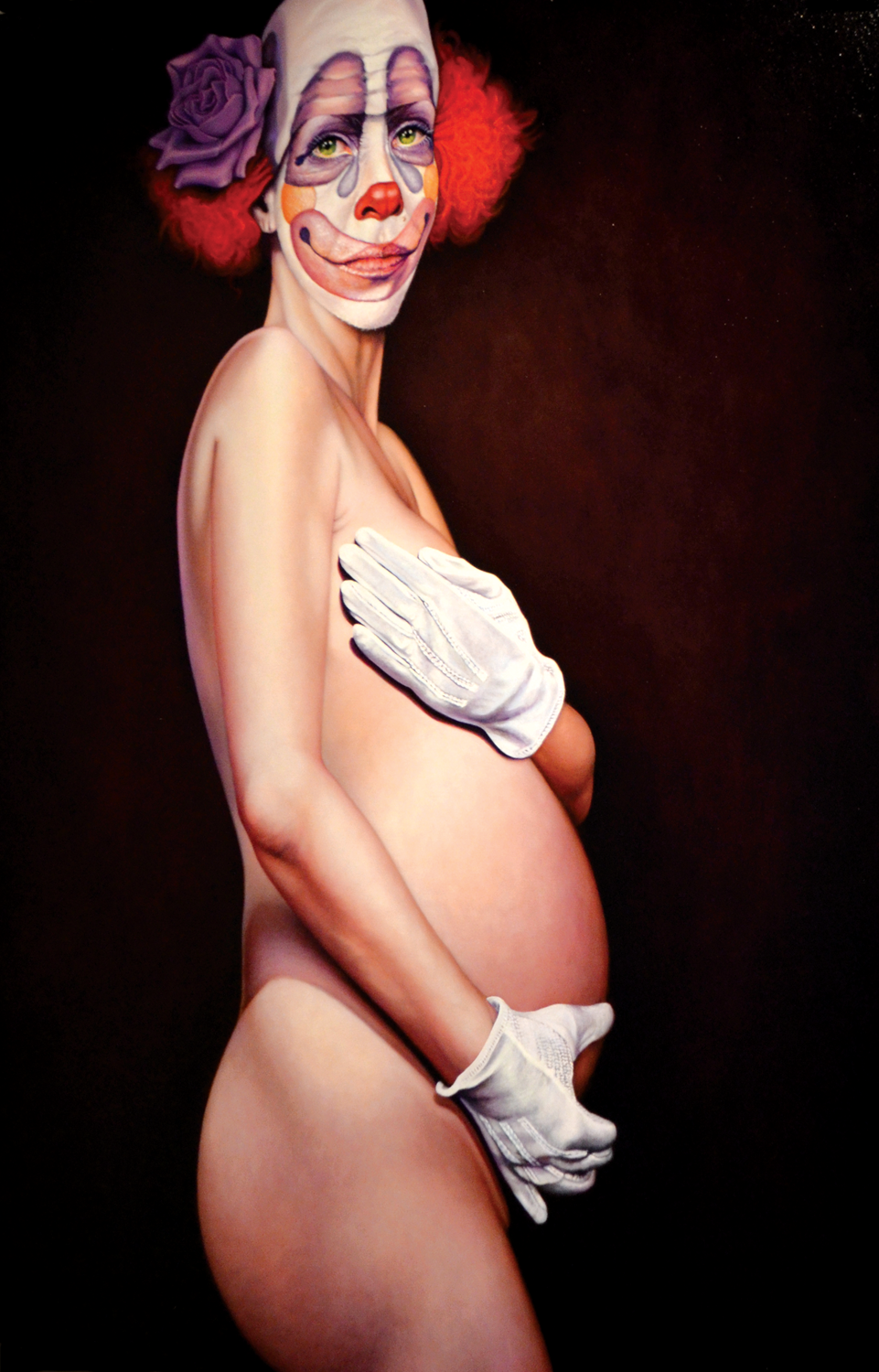PORTRAITS OF DESIRE
“Fixation” at Zhou B Art Center
POSTED ON APRIL 22, 2014
It’s the Madonna meets the Joker. Trapped behind the canvas’s glossy finish, a naked clown cups her breast with a gloved hand. The clown cradles a bulging womb with the other. This painting, installed at the Zhou B Art Center, belongs to “Fixation,” an exhibition that explores intense, and often kinky fascinations. Given the exhibition’s preoccupation with the psychological, curators Sergio Gomez and Didi Menendez quite strangely chose artworks that uniformly situated their subjects in a real world. The clown’s knife-slit grin, face-painted onto each cheek—collapsing into a pair of classically benign lips—helped furnish an easy formula for this consuming problem: Why so literal?
The exhibition’s persistent riddle lies not in its curious content but in that content’s weirdly rational and representational depiction. The twenty-four artists rendered their fantastical figures with life-like fidelity. A machine-woman staring into starry vacuum and two animal-headed humans walking their pet pit bull both believably belonged to our space and time. Every gear and gizmo down the bionic girl’s thigh was mathematically delineated and intricately decaled. I felt I could pet the fur on the latter couple’s deer-nosed snouts. Identifiably human forms dominated Gomez’s and Mendez’s walls. Neither a single abstracted mental landscape nor any impossible emotional gesture found its home there.
Terri Thomas executed her “Untitled” clown with academic fastidiousness. She concealed every brushstroke, smoothed every skin tone, and evenly diffused the painting’s light across a uniform burgundy background. The painting develops a motif of concealment that makes the clown the obsessive object. The gloves disrupt a tender tummy-touch and hide the source of motherly nourishment. The face paint blurs the clown’s feminine features—already challenged by the clown’s depilated skull and manly wrinkles—but nevertheless references an effeminate clown archetype. It grafts on false emotions that betray a deeper sadness just beyond a carefully resigned and benevolent smile.
Despite the figure’s absurdity, its hidden, weary pensiveness asserts dignity and commands respect. The visible attempt to conceal the body flags the painting’s emotional evasiveness. Thomas teases with the clown’s thinly veiled thoughtfulness. The barely legible affect is a visual breadcrumb that hints at the understated tragedy in the clown’s drawn expression and fake tears.
Miranda Graham’s “A Case of Living” straightforwardly asserts the same seeking sentiment through a prosthetic arm’s leather fastenings. Strung over the faceless subject’s bare back, Graham cites the established sexual urge to get past clasps and cinches to reach a concealed, essential fleshiness. Yet the figure’s nakedness undercuts this specific desire from the very start. The leather bands themselves take on organic qualities, confusing the body and its trappings. A blood-red zip of paint just below the figure’s right elbow traverses skin and strap alike. The zip unifies man and material with an incision of pain.
Conflating body and accouterment gets at the painting’s central question: the existence of the subject’s actual hand. Just as Thomas’s “Untitled” avoids definitively designating the clown’s gender or feelings, or offering any pictorial exposition at all, Graham’s “Case” suspends the painting’s action at the very moment of revelation. Both generate atmospheres of dissatisfaction and incompletion. Too little of Graham’s hand is revealed to verify that the fingers have actually been lost. The grip on the prosthetic’s pincers frames the mystery for the beholder. It directs eyesight to that location, and then shunts it above and to the right, where the living fingers ought to appear. “Case’s” thematic fixation becomes the presence or absence of a hand. We reach for the truth of her amputation while she reaches for the physical representation of her loss. But Thomas leaves the crowd empty-handed. Her nuanced deployment of strap-fetish produces the hunt for this fundamental, human signifier.
Thomas’s and Graham’s program of deliberately omitting the captivating object itself is reiterated with particular clarity in Harry Sudman’s “Imogen” sand Ernesto Marenco’s “Obsessive Fixation.” Split across six metal panels, “Imogen’s” titular woman leans forward towards the viewer, preeningly stroking her neck and chest. The beholder’s eye-level falls approximately on her breasts—or, rather, their suggestion. Their image is erased by the panel’s fission into two, separate halves. The upper half ends with the shallow curve of her neckline, and the bottom half resumes with the black fabric of her dress. In “Obsessive,” a little girl’s red, patent-leather shoes are fused to the glossy bottom of an enameled baking dish. The girl herself is frightfully missing, the dish scarred and the shoes warped and slightly browned with heat.
“Fixation” represents the urge to physically realize a desire by producing works that attempt to give these inchoate appetites credible shape and form. Yet by deliberately falling short of complete representation, the works approximate obsession’s process-oriented yearning. They urge viewers to the same, intense thought, fueled by the agony of near-fulfillment. Curators Gomez and Mendez suggest that fixation reduces vague wants into tangible totems, persistently imperfect and naggingly near.
Zhou B Art Center. 1029 W 35th Street. Through May 11. Monday-Saturday, 10am-5pm. Free.(773)523-0200. zhoubartcenter.com


